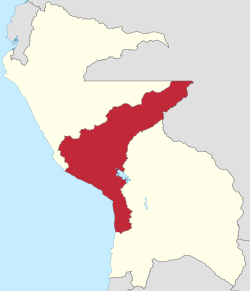Republic of South Peru República Sur-Peruana | |||||||||
|---|---|---|---|---|---|---|---|---|---|
| 1836–1839 | |||||||||
 South Peru within the Confederation | |||||||||
| Capital | Tacna | ||||||||
| Government | Presidential republic within a confederation | ||||||||
| President | |||||||||
• 1837–1838 | Ramón Herrera | ||||||||
• 1838–1839 | Pío de Tristán | ||||||||
| History | |||||||||
| 17 March 1836 | |||||||||
| 28 October 1836 | |||||||||
• Occupied | October–November 1837 | ||||||||
| 25 August 1839 | |||||||||
| |||||||||
| Today part of | Peru Bolivia Chile Brazil | ||||||||
The Republic of South Peru (Spanish: República Sud-Peruana) was one of the three constituent Republics of the short-lived Peru–Bolivian Confederation of 1836–39.
South Peru was one of two states—the other being North Peru—that arose from the division of the Peruvian Republic due to the civil wars of 1834 and 1835 to 1836. The states were founded in 1836 to be constituent Republics of the planned Peru-Bolivian Confederation, alongside Bolivia.[1]
The Confederation came to an end three years later after continuous border wars with Argentina and Chile in the War of the Confederation, and after a chaotic civil conflict between north and south Peruvians. In August 1839, Agustín Gamarra declared the Confederation dissolved; as a result, South Peru and North Peru reverted to being a unified Republic of Peru.
- ^ "Ley Fundamental de la Confederación Perú-Boliviana (1837)" (PDF). Congress of Peru. May 1, 1837.

